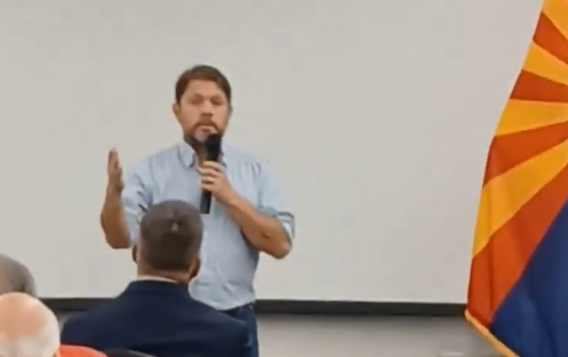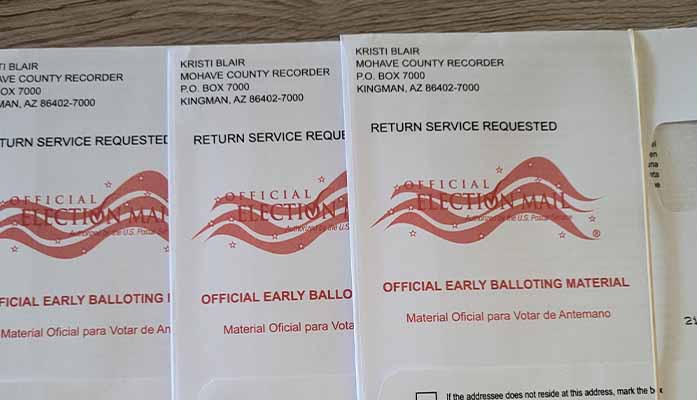
by Jonathan Eberle | Aug 15, 2025 | News
By Jonathan Eberle |
Scottsdale residents attending Monday’s City Council work study session will encounter a new layer of security at City Hall, the first council meeting since the summer recess.
The changes, implemented in July, require all visitors to pass through walk-through metal detectors or handheld screening devices, and have their bags checked at designated entry points. Signage directs guests to approved entrances and exits, where security personnel are stationed to assist and conduct screenings.
The security upgrades mirror measures rolled out earlier at Scottsdale’s One Civic Center, part of an effort city officials say is designed to enhance safety for employees, residents, and other visitors.
Under Arizona law (A.R.S. § 13-3102 A), weapons are prohibited inside City Hall. A secure lockbox is available at the entrance for the temporary storage of legal weapons.
City officials chose the summer for the rollout to coincide with a typically lighter meeting schedule, giving visitors and staff time to adjust before busier months ahead. Monday’s meeting will focus on WestWorld-related matters, but for those planning to attend, the city advises arriving early to allow extra time for the new security process.
Jonathan Eberle is a reporter for AZ Free News. You can send him news tips using this link.

by Matthew Holloway | Aug 14, 2025 | News
By Matthew Holloway |
In a letter to readers on Wednesday, Hank Stephenson, co-founder of the Arizona Agenda, dropped a bombshell that Gannett is reportedly buying out top reporters and columnists at the Arizona Republic.
The move follows Gannett’s decision to shutter its printing facilities in Arizona and the decision at News Media Corp that marked the end of five newspapers in outlying areas of Arizona.
Stephenson, a 15-year veteran journalist covering Arizona politics for the New York Times and Politico, wrote in part:
“The corporate morons at Gannett have offered another round of buyouts to their top talent at the Republic — and we’re losing some of the best reporters and columnists in Arizona.
“Among those that got bought out is “Agendie” winner and Arizona treasure Mary Jo Pitzl. Plus, we hear the list includes columnists Laurie Roberts, EJ Montini, Elvia Diaz, Phil Boas, among others.”
The story was posted to X by journalists Jen Fifield and Rachel Alexander. Fifield commented, “What will the Republic be without the great @maryjpitzl and its columnists. Thinking of all my journalism friends this week at the Republic and elsewhere. And our community.”
Alexander greeted the news with relish, writing, “The worst of the fake news local MSM in Arizona is finally no more! Granted, I agree that Mary Jo Pitzl wasn’t one of the worst, but Laurie Roberts and EJ Montini are two of the absolute worst fake news journos in our state.”
Garret Lewis, Host of The Afternoon Addiction on 550 KFYI, asked X at large, “Do you think USAID paid for any AZ Republic subscriptions?” alluding to reports that the agency paid for exorbitant subscriptions to various outlets, including Politico, as reported by Axios.
Lewis asked further, “Is it a coincidence that the USAID cash has dried up and now there is no more money for the AZ Republic? Hmmmm.”
On July 25th, Gannett Co., Inc., the parent company of the Arizona Republic, revealed that the historic broadsheet newspaper of Arizona would no longer be printed in the state, but rather would be printed at its Las Vegas facility and shipped into Arizona at the cost of 117 jobs and the closure of the paper’s massive Deer Valley Printing Facility in North Phoenix. At the time, Lark-Marie Antón, Gannett chief communications and brand officer, claimed in a statement that “The Arizona Republic will continue to provide readers with quality, local content that matters most to them,” and did not allude to any staffing changes at the newspaper.
Matthew Holloway is a senior reporter for AZ Free News. Follow him on X for his latest stories, or email tips to Matthew@azfreenews.com.

by Ethan Faverino | Aug 14, 2025 | Economy, News
By Ethan Faverino |
Intel Corporation is under fire following its receipt of significant funding from the CHIPS and Science Act, followed by recent job cuts nationwide and hiring a new CEO with ties to the Chinese Communist Party (CCP).
In November of 2024, the U.S. Department of Commerce finalized $7.86 billion of taxpayer dollars to Intel under the CHIPS and Science Act to support semiconductor manufacturing and advanced packaging projects in Arizona, New Mexico, Ohio, and Oregon.
This funding, part of a broader $100 billion investment plan by Intel, was intended to boost U.S. semiconductor production, create thousands of jobs, and enhance national security by reducing reliance on foreign supply chains.
In Arizona, the award was expected to support the construction of two new fabrication plants and the modernization of an existing facility at Intel’s Ocotillo campus in Chandler, creating 3,000 manufacturing jobs and over 6,000 construction jobs.
However, Intel’s announcement in August 2024 of a global workforce reduction of approximately 15,000 jobs, including 400 at its Chandler facility, has raised concerns about the alignment of these cuts with the CHIPS Act’s goal of fostering U.S. job growth.
The layoffs, part of a $10 billion cost-cutting plan prompted after a $1.6 billion net loss in Q2 2024, face criticism as Intel continues to benefit from taxpayer-funded incentives.
President Trump addressed these concerns about national job loss and a new CEO, saying, “The CEO of INTEL is highly CONFLICTED and must resign, immediately. There is no other solution to this problem. Thank you for your attention to this problem!”
This has gotten support from other GOP members across the country, with Senator Rick Scott following up, saying, “President Trump is right, Intel owes American taxpayers answers TODAY. Intel accepted tax dollars from the CHIPS Act, and instead of investing in America, they cut jobs in the U.S. and hired a CEO with a cozy relationship to the CCP. The CHIPS Act was intended to benefit America, not our adversaries. Intel should return every dime of this taxpayer funding IMMEDIATELY!”
Ethan Faverino is a reporter for AZ Free News. You can send him news tips using this link.

by Matthew Holloway | Aug 13, 2025 | News
By Matthew Holloway |
In his first town hall upon returning to Arizona from his visit to Iowa, where he was booed mercilessly, Democratic Senator Ruben Gallego was hosted by the Apache Junction Public Library on Monday. During the townhall, he spoke with veterans following a tour of the Cobre Valley Regional Medical Center in Globe.
According to AZCentral, Gallego was met with natural questions on his presidential aspirations, typically indicated by Senators taking jaunts to Iowa and New Hampshire, to which the Phoenix Democrat offered a boilerplate answer: “We’ve got to focus on Arizona.”
When pressed by a reporter, Gallego replied, “There is no presidential priority at all. The only priority is to make sure I’m doing the best for the state. Sometimes that might mean going to get help from other states, but the most important thing is delivering for us here.”
However, when confronted with more difficult questions, Gallego seemed less willing to engage, as indicated in video footage from X commentator ‘Veterans of Arizona.’
In a statement to AZ Free News, ‘Veterans for Arizona’ described his contentious interaction with the Senator saying, “I wanted to ask [S]enator Gallego some questions on his policies. When Ruben started going off about him helping veterans through the [PACT] Act….I realized he wasn’t going to call on me[,] so I decided to tell him that we couldn’t trust him because he’s previously voted against fully funding the VA[.]”
He asked, “[W]hy did he vote against Sam Brown’s nomination[?] [A]nd why wouldn’t he debate Kari Lake[?]”
“I was rushing these questions because his staff circled me and escorted me out,” he explained. “If Ruben wanted to make amends with vets he could’ve said: ‘[W]ait, what are your questions[?]’ and addressed each concern[,] but Ruben’s never been one for confrontation.”
In the Arizona Republic’s reporting, Gallego is described as “seem[ing] to embrace,” the “live-wire quality,” of engaging with the public, however, the prompt removal of ‘Veterans for Arizona’ by the Senator’s staffers seems to belie that notion. The Senator didn’t engage with the concerned veteran, but instead blithely ignored his questions as the man was unceremoniously ousted from the Apache Junction Library’s Opal Room.
Perhaps, after the embarrassing showing in Iowa, Gallego is less inclined to address the more aggressive discourse of his constituents.
Matthew Holloway is a senior reporter for AZ Free News. Follow him on X for his latest stories, or email tips to Matthew@azfreenews.com.

by Ethan Faverino | Aug 13, 2025 | Education, News
By Ethan Faverino |
A new report from the Common Sense Institute (CSI) revealed a crisis in Arizona’s district public school system, marked by declining enrollment, expanding infrastructure, and misallocated resources that fail to serve students effectively.
Despite a 5% drop in district school enrollment since 2019, Arizona’s public-school districts have continued to expand facilities, increase capital spending by 67% to $8.9 billion, and boost transportation costs by 11.3% to $561.2 million, even as eligible bus riders plummeted by 45%.
As Arizona’s population surged, districts expanded, constructing thousands of school buildings, hiring teachers, and extending bus routes to accommodate a growing student body.
Since peaking in 2008 with 931,000 students, district school enrollment has steadily declined, dropping to 859,519 students by 2024—a 5% decline since 2019 alone.
According to the report, this trend is accelerating, driven by demographic shifts and changing parental preferences.
Arizona’s school-aged population (ages 5–17) shrank for the first time in 2022, with a loss of 30,000 children by 2023.
Meanwhile, school choice has reshaped the educational landscape with 40% of incoming kindergarteners now opting for charter or private schools, which operate with leaner facilities and no formal transportation systems.
In the meantime, Arizona’s district schools have doubled down on expansion. Since 2019, districts added 499 new buildings, increasing gross square footage by 3% to 148.6 million square feet—78 million square feet more than needed, enough to accommodate 630,000 additional students.
The fastest-shrinking districts have increased capital spending the most, with 20% of districts (serving 73% of students) receiving 81% of capital funding.
Math proficiency in Arizona’s district schools fell 25% since 2019, and English proficiency dropped 5%, according to NAEP assessments.
Staffing has grown by 1.5% to 108,330 employees, with teacher salaries rising 24.1% to $65,113, yet class sizes remain stable at 17.7 students per teacher.
Administrative staffing has surged 6.7% since 2019, outpacing classroom staff growth, but these investments have not translated into academic gains.
Ethan Faverino is a reporter for AZ Free News. You can send him news tips using this link.

by Matthew Holloway | Aug 13, 2025 | News
By Matthew Holloway |
The Uniformed and Overseas Citizens Absentee Voting Act (UOCAVA) has become the center of controversies in Arizona in the past few days, involving Arizona’s Democrat Secretary of State Adrian Fontes and a raft of reforms to the act proposed by Congressman Abraham Hamadeh (R-AZ08).
According to a press release from State Representative John Gillette’s office (R-LD30), “Fontes ordered counties to abandon the secure, state-managed Uniformed and Overseas Citizens Absentee Voting Act (UOCAVA) ballot processing system and instead use a third-party platform controlled solely by his office.”
Gillette condemned Fontes, saying, “UOCAVA exists to ensure that our deployed service members, their families, and Arizona residents living overseas can securely exercise their right to vote. He explained, “It does not give voting rights to foreign nationals, illegal immigrants, or U.S. citizens with no prior Arizona residency. This directive is a reckless expansion of voting access beyond what the law allows.”
The release from Gillette’s office added, “The change undermines the clear intent of federal law, circumvents the Arizona Election Procedures Manual—which requires a public process and legislative oversight before such changes—and risks improper use of federal funds designated for legitimate UOCAVA services. Removing counties from control also weakens ballot verification and tracking safeguards that protect against fraud.”
In a statement released by the Secretary of State’s office, Fontes characterized his change as “the upgrade we’ve been working toward for 20 years.”
On the federal stage, the Proving Residency for Overseas Voter Eligibility (PROVE) Act, introduced by Rep. Hamadeh earlier this month, drew the ire of elections reporter Garrett Archer of ABC 15. The self-proclaimed “data guru” held the reforms to be unnecessary, according to the Arizona Daily Independent. Archer has been in an ongoing social media feud with Hamadeh and his staff regarding UOCAVA voting totals.
Introducing the measure, Hamadeh warned that the UOCAVA allows people who have never resided in the U.S. to vote in state elections, undermining the integrity of the electoral process. “The loophole in UOCAVA allows citizens living overseas, with no current ties to a state, to arbitrarily choose where their vote counts,” he said. “This threatens electoral integrity and is an affront to everyone who believes in fair and free elections. The PROVE Act will close this loophole and go far to restore trust in our elections.”
Hamadeh explained in a post to X:
“The military and overseas citizen voting data reveals some concerning patterns: Volume Stats:
• Total UOCAVA ballots transmitted: 1,327,324
• Here’s the kicker: 70% went to overseas citizens, not military voters
• That’s the largest gap between overseas civilians and uniformed services since 2014.”
Archer accused the congressman of “still lying. Just with numbers this time.” He argued, “The four states with a concentration of UOCAVA voters are Virginia, Florida, Washington, and California. The UOCAVA voters in the first three are all majority military. Virginia is near the seat of government, Washington and California both have aerospace and tech industries. Abe is implying its suspicious that a random county in Oklahoma or Nebraska DO NOT have over 100 UOCAVA voters. Quite the opposite in fact. If a random county in Oklahoma or Nebraska had over 100 UOCAVA voters, that would be suspicious.”
In response to another post from Archer, who shared his breakdown of UOCAVA registrations in 2024 by Arizona counties, Hamadeh asked, “Why aren’t you using the military numbers? Is it because it completely invalidates your rebuttal? This bill ensures that military voters are protected and loopholes are closed.”
Hamadeh then cited Hans von Spakovsky, Election Law Reform Initiative and Senior Legal Fellow at the Edwin Meese III Center for Legal and Judicial Studies: “‘The typical civilian Congress was looking at [when UOCAVA was created] was, for example, a State Department foreign service officer in Europe for a several-year assignment who would return to his or her home in Maryland or Virginia or another state when that assignment ended,’ Spakovsky told The Federalist. Spakovsky explained the legislation was surely not intended to permit expatriates, or other individuals who left the country and have no intention of ever returning, to continue voting.”
Answering the efforts of Adrian Fontes to interfere, and blasting the Democrat in a post to X, Hamadeh wrote, “Overstepping his authority & again demonstrating his flagrant disregard for the integrity of our elections, @Adrian_Fontes is exploiting voting in the name of the very servicemembers who protect that freedom. Congressman Hamadeh’s PROVE Act fixes this.”
Matthew Holloway is a senior reporter for AZ Free News. Follow him on X for his latest stories, or email tips to Matthew@azfreenews.com.






